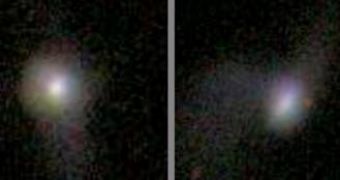Nothing can escape the gravitational pull of black holes, not even light; they draw in every bit of matter and energy passing beyond their event horizon. According to a new study, some of the heaviest black holes in the universe, weighing up to several billion solar masses and found in the cores of active galactic nuclei, use this property to emit high-energy jets in order to stop the star formation process in their home galaxy.
"The problem is that when you run these models and compare them to observations, what you find is that the models over-predict stellar mass in low-mass galaxies and in high-mass galaxies. There are too many stars.", said Sugata Kaviraj from Oxford University.
There are two distinct ways a galaxy can inhibit the star formation process inside it, depending on its mass. Lighter galaxies can stop star formation through supernova explosions that disperse the gas inside them.
But galaxies with masses 10 billion times that of the Sun or more cannot generate supernova explosions powerful enough to even out the gas distribution inside them, in order to stop star formation, since the gravitational pull of such a high accumulation of matter will not allow it. Therefore, the supermassive black holes in their cores have to take over the tasks of supernovae and impede star formation.
When matter falls towards a black hole, part of it is converted into energy and is ejected into the surrounding space in the form of high-energy jets through the polar regions. These particular types of black holes are called active galactic nuclei and have enough power to affect the gas inside their galaxies, so that star formation is stopped.
"The problem was that people used these supernovae and AGN prescriptions to match the models to the observations. However, there was no evidence that this is actually how nature works", said Kaviraj.
With the help of ultraviolet observations made with NASA's Galaxy Evolution Explorer and optical images from the Sloan Digital Sky Survey, Kaviraj started investigating post-starburst galaxies which appear to have gone through a star formation process that stopped suddenly about one billion years ago.
Kaviraj and his colleagues discovered that there is a tight relationship between the mass of the galaxy and the star formation inhibition rate and that in galaxies with masses smaller than 10 billion times that of the Sun the inhibition rate slowly decreased as the galaxy increased its mass, which stands as evidence that in these galaxies the process is regulated by supernova explosions.
For heavier galaxies however, it seemed that the star formation process decreased even more dramatically with the increase in mass, as powerful black hole jets started kicking out gas.
Additionally, galaxies with masses higher than 10 billion times that of the Sun are more likely to have active galactic nuclei than lighter galaxies. The current model is only based on observations of galaxies in the near vicinity of the Milky Way; however, a later more detailed study will also include galaxies with active star formations that took place 10 billion years ago.

 14 DAY TRIAL //
14 DAY TRIAL //